

How to Write a Cover Letter Addressing Selection Criteria in 10 Steps

Written by Nicole Wren

#ezw_tco-9 .ez-toc-title{ font-size: 120%; font-weight: 500; color: #000; } #ezw_tco-9 .ez-toc-widget-container ul.ez-toc-list li.active{ background-color: #ededed; } Table of Contents Toggle Table of Content Toggle
by Nicole Wren | Jan 29, 2024 | Writing Advice
Some job applications will ask you to provide a response to selection criteria , as well as your resume or CV. These criteria are the specific skills and experience that a job requires. In many cases, the application guidelines request that the selection criteria should be responded to within a cover letter. (Sometimes, they request a response in a different format, like this APS Statement of Claims example ). Many people wonder how to write a cover letter addressing selection criteria, though (as selection criteria writers , we get asked daily!).
While your resume or CV should state that you have the relevant experience, a selection criteria response will require more detail and specific examples. As well as providing more information, selection criteria also provide a structured way to assess candidates.
The job ad might include something like this:
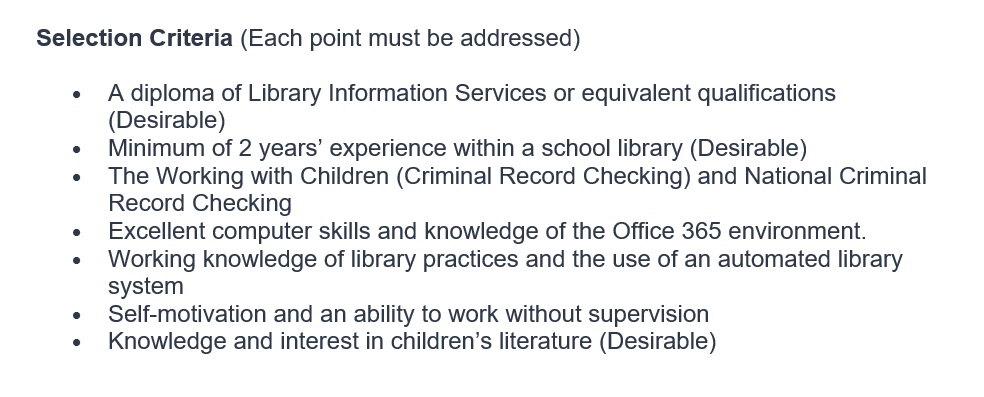
Let’s look at 10 things to keep in mind when addressing selection criteria in a cover letter.
1. Start Your Cover Letter in the Standard Cover Letter Format
Begin your cover letter in the standard format, with a header containing your contact information. Then, include the employer’s contact details, including their name (or a generic salutation like “Dear Hiring Manager”). Use a standard font and font size, like Arial 10-12.

2. (Opening Paragraph): Express Your Enthusiasm
Specifically state the role you are applying for. Convey your eagerness to contribute your skills and experience to the organisation. You might also like to mention the company’s values, and how your own align (tip: be specific and authentic here). If there is something else that attracts you to the organisation (such as a recent company achievement), you might like to mention it here, to show you have a good understanding of them.

3. (Body Paragraphs): List and Highlight Each Selection Criteria
List and highlight each of the selection criteria in the body of the cover letter. This will help you keep on task and ensure each selection criterion is adequately responded to (note: you should remove this at the end – see step 9).

4. (Body Paragraphs): Paraphrase Each Criterion and Your Experience
Write an introductory sentence for each criterion, paraphrasing the language and keywords used in the selection criterion.

5. (Body Paragraphs): Brainstorm Ideas for Each Criterion
Make some notes within your document, then choose your ‘best ideas’. Tip: you’ll need to be as specific as possible. Rather than saying you communicated daily with different customers in a previous role, think of a specific time you communicated with a specific customer, and how you had a positive impact.
6. (Body Paragraphs): Use the STAR Format for Each Example
The STAR format is a well-known way to structure selection criteria. It goes like this:
Situation (S): Briefly set the context by describing the situation or problem you encountered. Keep it concise to provide necessary background information. This section should make up approximately 10% of your response.
Task (T): Describe your specific role or task within the situation. Explain what was expected of you and any challenges or goals you needed to address. This section should make up around 10% of your response.
Action (A): This section should make up around 60% of your response. Describe the actions you took in detail. This is where you showcase your skills, competencies, and problem-solving abilities. Use specific examples, highlight your contributions, and explain your thought process.
Result (R): Approximately 20% of your response. Conclude by outlining the positive outcome or result of your actions. Mention any benefits to the organisation. While this is one of the smaller sections, it is one of the most important. Many candidates forget to include a strong result section.
Note, the STAR method is not necessary for yes/no criteria such as certain qualifications. For these criteria, you can simply state that you have the required qualifications.

7. (Conclusion Paragraph): Sign-off Positively
Conclude your cover letter with a short paragraph thanking the reader for their time, and welcoming the opportunity for an interview. You may like to reiterate your interest in the role.

8. Sign Off as in a Standard Cover Letter
End with a professional sign-off such as ‘Kind regards’ or ‘Yours Sincerely’, along with your full name. There is no need to sign the cover letter.

9. Remove the Highlighted Selection Criteria
Since these headings were included only as a guide for you, you should now remove them. Your introductory sentence within each paragraph will be enough to allow the reader to understand that you have addressed each one.
10. Proof-Read and Submit
Proof-read your document for any errors, including grammar and spelling. You may like to have a friend or family member complete this part for you. Another tip is to save the document as a PDF, and read through it that way (the doucmnet will look slightly different and will allow you to assess it with fresh eyes).
Cover Letter Addressing Selection Criteria Example
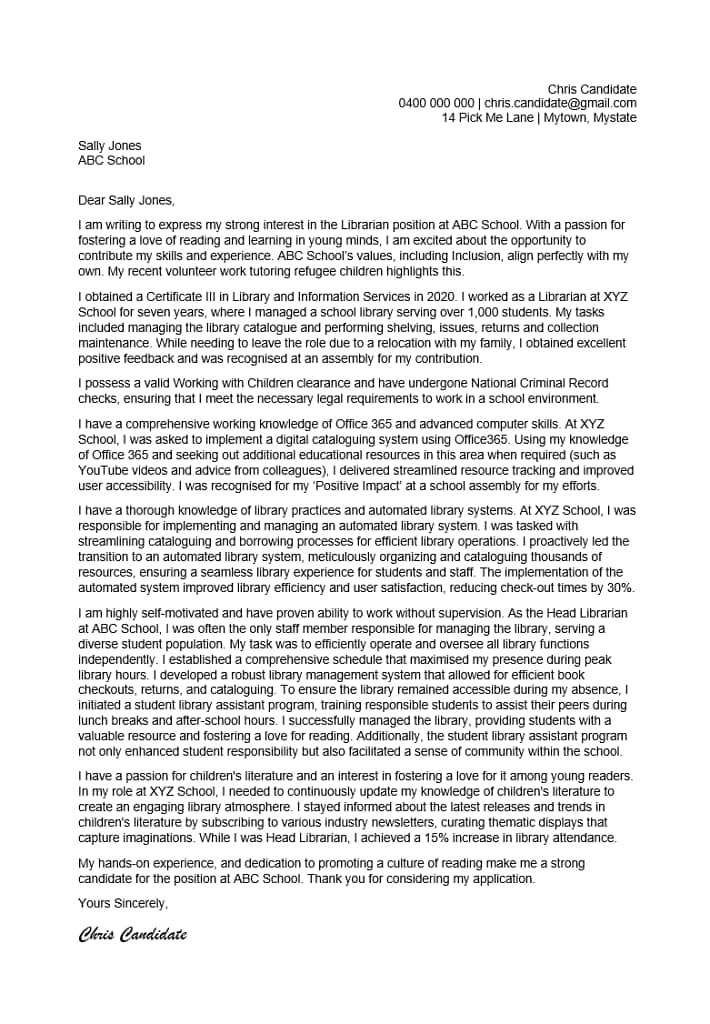
Frequently Asked Questions
Can you address selection criteria in a cover letter.
There are a few different formats for responding to selection criteria. Sometimes, you may be asked to respond to specific online questions related to the criteria. Sometimes, you may be asked to provide a ‘separate document’ style selection criteria response. Sometimes, you can address selection criteria in a cover letter. It is important that you thoroughly read the application guidelines to determine what is required.
How long should a cover letter addressing selection criteria be?
A cover letter addressing selection criteria should typically be between one to two pages. If the application guidelines specify a length, you should always adhere to that.
How to address selection criteria you don’t meet?
Selection criteria are sometimes deemed either essential or desirable. You should provide a response to both essential and desirable criteria, even if you don’t meet them. You should provide a summary of your most transferrable skills and experience.
Our selection criteria writers specialise in addressing selection criteria, both in cover letter and other formats.
Contact us if you need more assistance with your application.
Read our latest resume tips .

Nicole Wren
Senior Writer
Nicole is the principal resume writer at Resumes to Impress. Nicole loves writing and sharing her knowledge about all things job hunting and career guidance.
Recommended Services:

Selection Criteria Writing
- Adelaide Resume Writers
- Resume Writers Bendigo
- Resume Writing Service Brisbane
- Resume Writing Services Cairns
- Resume Writing Services Canberra
- Resume Writers Darwin
- Resume Writers Diamond Creek
- Resume Writing Services Geelong
- Resume Writing Services Gold Coast
- Hobart Resume Writers
- Resume Writers Launceston
- Resume Writers Mackay
- Melbourne Resume Writers
- Resume Writing Services Newcastle
- Resume Writers Parramatta
- Resume Writers Perth
- Resume Writers Sunshine Coast
- Resume Writers Toowoomba
- Resume Writing Services Townsville
- Resume Writers Wollongong
- Interview Coach
- LinkedIn Profile Writer
- Resume Writing Services For Veterans
- Mining Resume Writing Services
- Nurse Resume Service
- Professional IT Resume Writing Services
- EXPLORE Random Article
How to Address Key Selection Criteria in a Cover Letter
Last Updated: May 23, 2020 References
This article was co-authored by Shannon O'Brien, MA, EdM . Shannon O'Brien is the Founder and Principal Advisor of Whole U. (a career and life strategy consultancy based in Boston, MA). Through advising, workshops and e-learning Whole U. empowers people to pursue their life's work and live a balanced, purposeful life. Shannon has been ranked as the #1 Career Coach and #1 Life Coach in Boston, MA by Yelp reviewers. She has been featured on Boston.com, Boldfacers, and the UR Business Network. She received a Master's of Technology, Innovation, & Education from Harvard University. There are 12 references cited in this article, which can be found at the bottom of the page. This article has been viewed 64,282 times.
If you're applying for a job, you may be unsure how to write the cover letter or how to include key selection criteria. The key selection criteria, also known as the job requirements, are the main things your potential employer wants to see, and you must address each one in your cover letter. Start by figuring out exactly what the employer wants, and address them in the body of your letter. Follow up with a thorough proofreading, including checking your cover letter against the selection criteria.
Breaking down the Key Selection Criteria

- You could also ask the opinion of someone you know to see what they think it means.
- Some countries, such as Australia, require that all public-sector jobs provide a list of key selection criteria.

- For instance, maybe the job description states the following: "The employee will act as an intermediate between clients and the accounting department. They will take phone calls and emails from both sides, and they will be expected to communicate professionally."
- From this text, you can gather that one of the key criterion for the position is to be able to communicate on a professional level with both clients and other staff members.

Structuring Your Cover Letter to Fit the Criteria

- For instance, you might write, "My name is Jessica Roberta, and I am applying for the position of invoice coordinator, a position I heard about through a friend, Jerry Flores. I am uniquely suited for this position due to my 20+ years experience in invoicing, as well as the positions I've held as an administrative assistant."

- "I am applying for this position because I have the initiative, organizational skills, and relevant computer experience you are looking for in a candidate."
- Move on to discussing your examples of each criteria.

- Keep it concise and to the point, as you don't have much space in a cover letter.
- For instance, maybe you wrote, "training book project at the accounting firm," "burger job," and "school project." Pick the most important one.
- You could write, "I often take initiative on projects. For instance, when I realized my accounting firm didn't have a training manual, I took the initiative to create one myself."

- For instance, with good organizational skills, you might say, "I have strong organizational skills." Then go on to your example: "I reorganized the filing system for the office I worked in, and efficiency improved by 25%."
Shannon O'Brien, MA, EdM
In the middle paragraph, include five bullet points that state your experience. Make your points relevant to the job you're applying for. Keep your cover letter short and concise with about three paragraphs and bold a couple of the essential words to make them pop off the page.

- For example, you might write the following closing paragraph: "In closing, I would love to work for Invoicing Brands. My valuable experience would make me a great fit. Thank you for your time, and if you need to reach me, I am available all this week and next at 123-456-7890 or [email protected]." [9] X Research source
Providing Examples and Checking Your Work

- For instance, you might write, "In my position as an invoice manager, I was able to submit invoices on time 98% of the time. I managed that by prioritizing incoming invoices and working quickly to get them done. Then I finished the rest of the work that needed to be done in the office."

- For example, you could write, "I have shown resiliency in past positions, particularly when I worked on a training manual at XYZ Financials. It took me several months to complete the project, partly due to lack of support and printing issues, but in the end, I persevered. XYZ Financials now has a training manual to be proud of."

- For example, you might write, "At my position with XYZ Financials, I noticed staff members wasted time because of an inefficient filing system. No one wanted to shut down the area long enough to reorganize it during the week. I came up with an innovative solution, a weekend refiling extravaganza. We took one weekend to completely reorganize the area."

- For instance, maybe 3 of the criteria are "good organizational skills," "takes initiative," and "competent computer skills."
- You might write, "In my position as an office clerk, I built a database to reorganize the office filing system. Efficiency improved by 25% in the office, and my manager was impressed by my computer skills, my organizational abilities, and my initiative."
- Read through your letter. As you do, check off each of the key selection criteria you were supposed to cover. Make sure you included as many as you could in the letter.

- For example, don't say, "My organizational skills aren't great, but I am fantastic on the computer."
- Instead, say, "My computer skills are above par, as evidenced by the fact that I developed a database for our filing system in my last position."

- Make sure you have spelling and grammar check enabled on your document to help you catch mistakes.
- Ensure you've set a formal tone throughout. A formal tone is more professional than an informal tone. Don't use slang, and avoid contractions. You can use jargon specific to your field, but only if you're sure your potential employer will know it. [16] X Research source
- Once you've polished it, let another person proofread it. You can ask someone you trust professionally, for instance. If you're a student, take it to the career center if your campus has one. [17] X Research source

- When looking for flow, check that each sentence moves smoothly into the next one. For instance, you might write the following sentences: "I gained experience in computer skills at my position at XYZ Financials. Because of this position, I have experience in Microsoft Office and databases."
- They flow together because you use one sentence to transition into the next, referencing the position from the previous sentence to begin the following sentence.
Expert Q&A
You might also like.

- ↑ https://careers.vic.gov.au/vacancies/key-selection-criteria
- ↑ https://www.monash.edu/career-connect/jobs/apply/selection-criteria
- ↑ http://www.jobs.uwa.edu.au/applying/written/addressing
- ↑ http://www.uvm.edu/~career/?Page=letter.html&SM=jobsubmenu.html
- ↑ https://owl.english.purdue.edu/owl/resource/723/03/
- ↑ http://www.jobs.uwa.edu.au/applying/written/letter
- ↑ https://www.washington.edu/doit/key-elements-cover-letter
- ↑ https://owl.english.purdue.edu/owl/resource/723/01/
- ↑ http://writingcenter.unc.edu/tips-and-tools/flow/
About this article

When writing a cover letter, you can give yourself the upper-hand by addressing each job requirement. First, carefully read through the job description and and highlight the requirements, like good communication skills or the ability to work under pressure. Then, write an example of your relevant education, training, or past job experience for each requirement so you can back them up with evidence. Use the body of your cover letter to address the requirements. If you have space, write a short paragraph for each requirement and link each one to a specific example from your experience. If this would take too much space, group together similar requirements with one example. For more tips from our Career Coach co-author, including how to write a compelling intro and conclusion to your cover letter, read on! Did this summary help you? Yes No
Reader Success Stories
Hamida Begum
Jun 30, 2022
Did this article help you?

- About wikiHow
- Terms of Use
- Privacy Policy
- Do Not Sell or Share My Info
- Not Selling Info

- List of services
- Employment services
- Current vacancies
- Register for job alerts
- Become a temp
- Submit your CV
- Other services
- Payroll services
- International candidates
- Job hunting blog
- Recruitment services
- Permanent recruitment
- Executive search
- Temp recruitment
- SEEK advertising
- DISC profiling
- Outplacement
- Payroll outsourcing
- Contingency vs retained
- Recruitment blog
How to address key selection criteria in a cover letter
This article is recommended for individuals near the beginning of their careers, introduction.
Having spent a significant portion of my career in the realm of recruitment, I've come to understand the importance of job seekers ably addressing the key selection criteria of a vacancy in their cover letter.
It can truly make or break your job application. This is particularly true when an employer has noted these criteria as basics.
Allow me to share with you a step-by-step guide for taking on the key selection criteria within your cover letter.

How to address selection criteria
Understand the criteria.
As a start, read over each of the key selection criteria talked about in the job ad. Make sure you have a clear grasp of what the employer is looking for in a candidate.
Create a table or list
Sort the key selection criteria into a table or a list format. This will help you keep track of each criterion and your answer to it.
Use specific example
For each criterion, give specific examples from your past work experiences, education, or other related aspects of your background that show your skills, abilities, and experiences related to that criterion. Be sure to talk about your achievements, responsibilities, and any measurable results.
Follow the STAR method
When discussing each criterion, try using the STAR method (Situation, Task, Action, Result) to write your responses. Describe the situation or context, the task you had to carry out, the actions you took, and the results you gained. This is a clear and concise way to show your qualifications.
Highlight relevance
Make a strong link between your qualifications and the requirements of the job. Explain how your skills and experiences align with the specific criteria and how they will elevate your success in the role.
Tailor each response
Customise your answers for each criterion to match the language and terms used in the job ad. This shows your attention to detail and that you've carefully thought about the employer's needs.
While giving detailed examples is important, aim to keep your responses concise and focused. Avoid undue elaboration or extra details that could take away from the main points.
Prioritise & order
Cover the key selection criteria in the order of importance as shown in the job ad. If the criteria are not explicitly ranked, try addressing them in the order that best reveals your strengths and relevance to the role.
After drafting your responses, carefully edit your cover letter to ensure it is free of errors, typos, and grammatical mistakes. A well-written cover letter shows your professionalism and attention to detail.
Overall cover letter structure
Integrate your answers into the overall structure of your cover letter. Start with an introduction that briefly talks about the role you're applying for and why you're interested. Then address the key selection criteria, using a paragraph for each criterion. Finally, finish with a summary of your enthusiasm for the role and your availability for further discussion.
If you're looking for more in-depth help with cover letter writing, please click the button below to read my free e-book on the topic.
By following these steps, you'll be able to effectively discuss key selection criteria in your cover letter, making a great case for your suitability for the job.
Remember to customise each cover letter for the specific position you're applying to, as a tailored approach is more likely to capture the employer's attention.
For further assistance, I recommend you check out myfuture's article: How to respond to key selection criteria .

Are you looking for a job?
Now that you understand how to address key selection criteria in a cover letter, you should take a moment to check our current vacancies page .
At 11 Recruitment, we have a range of white-collar temp and perm jobs available. We're always on the lookout for top talent to place with our clients, so we encourage you to apply for any positions that are of interest.
If none of our current vacancies are right for you, you should register for job alerts . Then we’ll be able to notify you when we receive a position that matches your profile.

How to send a follow up email after networking

How is the job market in Perth?

How to take a good profile picture for LinkedIn

How to get your dream job

What to expect in a second interview

How to impress in an interview

How to stand out in a group interview

How to identify transferable skills

Examples of hobbies and interests in resume

How to demonstrate leadership

How to write a LinkedIn summary

Are job applications confidential?

How to handle screening calls

How to build a personal brand on LinkedIn

How to prompt ChatGPT to write a cover letter

How to ask someone to be a referee

How to write availability on a resume

How to add experience to LinkedIn

How to network to get a job

What to say if you’re late for an interview
Click here to learn more about 11 Recruitment

What are your thoughts?
I'd love to have a conversation with you about this topic - please leave a comment below if you have any thoughts or opinions 🙂
Christian Madsen
Managing Director of 11 Recruitment
How to resign
Do recruiters look at social media, what to post on linkedin.
Session expired
Please log in again. The login page will open in a new tab. After logging in you can close it and return to this page.
Two-Page Cover Letter Addressing the Statement of Duties
- Post author: theresumewriters
- Post published: January 12, 2019
- Post category: Australian Public Service / Cover Letters / Selection Criteria
- Post comments: 2 Comments
Two-page cover letter addressing the statement of duties/selection criteria
The format which has all but wholly replaced traditional selection criteria.
By Jacquie Liversidge
Navigate to:
How to write a 2-page cover letter that addresses government requirements.
More and more, there are content length limitations placed on selection criteria responses, and the majority of the time, these are two pages, or roughly 1500 words.
This has been implemented by the Commonwealth and most state governments in response to enormous selection criteria responses being submitted for government roles, jam packed with empty content which doesn’t demonstrate an applicant’s capabilities.
When applicants write their selection criteria, there is a tendency to fill the selection criteria with ‘padding’, or useless material, to increase the length with the idea that more is better.
Length certainly isn’t everything. When it comes to selection criteria, you want to get your material out quickly and efficiently with the most impact and the lowest word count.
You want to use your audience’s limited time well.
And this is where directions for a two-page cover letter come in to play.
How to spot it when it applies
Either on the applicant guide or the initial link to the prospective role, there will be a section titled ‘How to Apply’.
Read this section carefully and make sure you are aware of what the directions are.
How to interpret the position description
Click on the position description and look over what is listed therein.
On the position description for most government applications, you will usually find the following sections titled exactly like this, or very similarly:
- Position Objective
- Role context
- Responsibility
- Knowledge, Skills and Experience (Selection Criteria – in relation to the major duties)
Selection criteria can also be called Essential Requirements, Role Specific Requirements, Success Criteria. Nonetheless, the easiest way to spot these questions are by looking for dot-pointed content that looks a bit like this:
eg. – Demonstrated ability to provide consumer-centred care
– Exceptional communication skills and conflict resolution skills.
– Proven report writing capabilities.
Once we have a good idea of the important background, context, and scope, and we’ve found the selection criteria we need to respond to, we can start on our content. Here’s a bunch of over ten detailed selection criteria examples to get you started.
Here’s an example of a two-page cover letter addressing the required sections Queensland Government. Increasingly, these questions are values based, as they were below :
Two-page statement example
The structure, introduction: why you’re applying, what you’re offering, and why you’d be a great fit, the selection criteria question restated which is entirely optional. it’s also appropriate to skip this part, and move on to the next., our response, with the topic sentence (first sentence) repeating the question. (do this for all questions), a call to action (cta) statement ending the cover letter, professional sign-off, tips, tricks, and other information to note:.
If it’s a two-page cover letter for a government role, and it says nothing about addressing the requirements of the role, but there is selection criteria present, you do still need to address the selection criteria.
Traditionally, where the position description/advertisement asks for responses to the selection criteria, you would develop your questions and title them with the question. This approach is exactly the same, but incorporates the cover letter element of an introduction statement, and it simply does not contain the selection criteria within the documents as headings.
The point of the exercise is demonstrate your capability to perform in the role via examples of your ability to do that prior. The only part of the story which demonstrates your capability, are the actions that you took.
Focus on the inner content
Save your space for the real content that will get you selected by keeping your introduction short and to the point, and your call-to-action statement at the end within 2 sentences.
Introduction example:
I wish to submit my application for the position of Communications Officer as listed on the Tasmanian Government jobs website. I am confident I would be an ideal candidate for the position given my extensive experience within the corporate communications environment, my proven successes in a variety of roles and my strong interest in supporting strategic objectives through strong external communication.
Call-to-Action example:
Thank you for taking the time to consider my application for the role of Communications Officer. Please do not hesitate to contact me on the details contained herein for further information or to arrange an interview.
Keep your content focused on the selection criteria. Keep it concise and make every word count.
And that’s all folks.
Happy hunting!
You Might Also Like
Selection criteria is disappearing. is star dead, what is active and passive language and why it matters., the number one question to ask: getting into the public service, this post has 2 comments.
Pingback: Applying for Australian Government Jobs - State by State | The Resume Writers
Pingback: How to use STAR in selection criteria & cover letters | The Resume Writers
Leave a Reply Cancel reply
This site uses Akismet to reduce spam. Learn how your comment data is processed .
Get a Quote
Book a 15 minute call/Teams meeting
The Resume Writers acknowledges the traditional custodians of the lands on which our business operates. We pay our respects to ancestors and Elders, past and present.
- Book a Discovery Call
- Resume Writing
- Government Selection Criteria
- Get In Contact
- How It Works
- Terms, Conditions and Privacy Policy
- 1300 272 477
- 5/18 Elizabeth Street Hobart TAS 7000
- 903/50 Clarence St, Sydney NSW 2000
- Level 8, 805/220 Collins St, Melbourne VIC 3000
- 9/204 Alice St, Brisbane QLD 4000
- 202/37 Barrack St, Perth WA 6000
- 3/55 Gawler Place, Adelaide SA 5000
- [email protected]
- Monday - Friday 9AM - 5PM
© All rights reserved
Discover more from The Resume Writers
Subscribe now to keep reading and get access to the full archive.
Type your email…
Continue reading
10 selection criteria examples for your resumé
When you’re browsing job ads, you’ll notice that many of them ask you to respond to selection criteria in your cover letter. But what are they exactly? They’re the skills, knowledge and qualifications the employer thinks are essential for succeeding in the role.
By addressing these criteria in your cover letter, you can improve your chances of advancing to the next stage of the recruitment process . In this article, we explore more about what ‘key selection criteria’ is, look at common criteria on job ads, and provide a selection of criteria response examples you can use as a guide for your cover letters.
What is ‘key selection criteria’?
Key selection criteria are the qualities, skills, knowledge and experience that a job seeker needs to be able to perform in a role. A list of key selection criteria on a job ad tells you which attributes the employer thinks you need for the position. This list allows hiring managers to efficiently assess the job applications they receive.
As a job seeker, it’s important to pay attention to the key selection criteria of every job you apply for, to figure out whether you’re a good fit for the role. If you match these criteria, you can use the selection criteria list as a guide when preparing your job application, to ensure you address the job role’s essential requirements.
Common types of key selection criteria
There are different types of key selection criteria, often categorised into three main groups: technical skills, soft skills and personal attributes. By addressing each of the different types of key selection criteria, you can show the hiring manager that you’re suitable for the role.
1. Technical skills
Technical skills refer to specific knowledge and abilities required to perform particular tasks. These are often acquired through education, training or previous work experience and are directly related to the job’s duties.
Examples of technical skills include:
- Proficiency in software like Microsoft Office or Adobe Creative Suite
- Familiarity with coding languages such as JavaScript and Python for technical roles
- The ability to operate specialised equipment (tools, machinery, medical equipment, electrical appliances, etc.)
2. Soft skills
Soft skills are interpersonal skills that determine your ability to work and interact with others. While soft skills are less tangible, they’re just as important as hard skills, and essential for successful teamwork, stakeholder management and problem solving.
Sought-after soft skills include:
- Communication skills, including both verbal and written
- Leadership and team-building skills
- Time management and organisational abilities
3. Personal attributes
Personal attributes are traits or qualities that shape how you approach work and collaboration. These are often reflective of your work ethic, attitude and personal values .
Examples of valuable personal attributes include:
- Adaptability, or how you adjust to changes or handle unexpected challenges
- Attention to detail, or your ability to do accurate, error-free work
- Resilience shows that you can overcome setbacks
10 key selection criteria examples
After identifying the job’s key selection criteria, it’s important to tailor your application to suit. Here are some common criteria often listed in job descriptions, along with a few tips for addressing selection criteria, with examples.
Communication skills
Communication skills refer to your ability to clearly convey information, verbally and in writing, to different audiences. They’re important across a range of roles whether you’re working as part of a team, liaising with clients or customers, or taking on a leadership role .
Here are a couple of examples addressing selection criteria to do with communication.
I have a high level of communication skills, both verbal and written. In my previous role, I was often meeting facilitator and took minutes for my team’s weekly meetings. I also attended departmental meetings, providing updates on project milestones and addressing questions from stakeholders.
During my time as a customer service representative, I demonstrated exceptional verbal communication skills when dealing with guests. In most instances, I was able to diffuse situations by working with the customer to understand their issue and provide a resolution without escalating to my manager.
Strong analytical and problem-solving skills
Analytical and problem-solving skills refer to your ability to analyse situations, identify underlying issues, and implement practical solutions. Employees with strong analytical and problem-solving skills can help improve efficiency and productivity in their workplaces.
My current role as a project manager requires strong analytical and problem-solving abilities. My responsibilities include identifying bottlenecks and testing solutions to streamline our workflow.
Ability to work well under pressure
When you work well under pressure, you’re able to maintain performance standards and manage priorities in challenging situations. These skills are important in the workplace for meeting deadlines while maintaining work quality.
My current role as a graphic designer frequently involves juggling competing projects. To keep my work quality high, I have developed strategies to help me prioritise, and I truly enjoy the excitement and energy of working in a fast-paced environment.
Demonstrated leadership skills
Leadership skills refer to your ability to guide, motivate, and inspire a team toward achieving organisational goals. Whether you’re looking to move into a leadership role or wanting to take the lead on a project, leadership skills can help advance your career .
I have proven leadership skills, demonstrated in my last two roles, where I have led teams to exceed their KPIs. I currently manage a five-person team, delegating tasks, overseeing work, and encouraging collaboration, to meet and exceed project milestones. I have the lowest staff turnover rate of any team leader in my company.
Commitment to continuous professional development
Many employers value continuous professional development . Showing a commitment to lifelong learning shows that you’re proactive in developing your skills and knowledge, and will work to keep yourself an asset to your employer.
I am dedicated to continuous professional development, actively seeking opportunities to improve my skills and knowledge in my field. I regularly attend workshops, webinars and industry conferences, and have a list of recent certifications.
Technical proficiency
Technical proficiency involves possessing specific technical skills or knowledge relevant to the role. This varies depending on your industry, with each role requiring specific skills and knowledge.
I regularly update my skills through online courses and on-the-job training. I believe it’s important to stay informed about advancements in my field and also to contribute my own knowledge to help others. I keep up to date by subscribing to industry newsletters and attending local workshops.
Ability to work as part of a team
Effective collaboration involves working with others to achieve common goals. It’s important for all workplaces, because it means you’re an easy person to work with. Ability to work as part of a team includes things like supporting colleagues and keeping an open mind about others’ perspectives.
I believe I work best as part of a collaborative team, paired with other professionals who inspire and support each other. I have years of experience working in teams with diverse backgrounds and from different disciplines, and genuinely enjoy the social aspect of collaborating with others.
Effective time management
Time-management skills are highly valued by employers. They refer to your ability to prioritise tasks and use your time efficiently to meet deadlines. Not only does this help improve the quality of your work, but it can also help reduce stress .
Through years of being a private tutor, I have developed excellent time-management strategies, allowing me to book up to 20 students per week without sacrificing the quality of my teaching. I have many long-term students that I have helped throughout entire degrees to graduation.
Attention to detail
Attention to detail means performing tasks with precision and accuracy. By paying attention to the finer details, you can reduce the chance of errors and produce higher quality work.
I am detail-oriented and take pride in my work, paying close attention to small details and often picking up small errors that other people miss.
Adaptability and flexibility
Flexibility is a personal attribute that is highly valued among employers, so it’s often worth demonstrating your capability to adjust to new challenges, work in unpredictable conditions, and adapt to changes in the workplace. Example:
I am a flexible and adaptable worker who welcomes new challenges. I’m always open to learning new skills and processes, as demonstrated by my role as unofficial team trainer in my current position. I’m always the first to volunteer upskilling my co-workers.
As a job seeker, it’s essential to identify the selection criteria listed in a job ad, and address each point in your job application. Pay close attention to what the hiring manager is asking for and adjust your resumé and cover letter to include these specifics. By matching your application to the selection criteria, you’ve got a better chance of making it through the application stage to an interview.
What is the best selection criteria?
The best selection criteria will depend on the role as well as the objectives and values of the hiring company. The best selection criteria to have are the ones that match the requirements and objectives of the job, as listed in the ad.
What should be included in selection criteria?
Selection criteria should include specific attributes, qualifications, skills and experience deemed essential or desirable for a job. The selection criteria should address all relevant aspects of the role: qualifications, experience, skills and personal attributes.
What are the five selection criteria?
Selection criteria typically fall under five categories, including:
- Qualifications
- Technical skills
- Soft skills
- Personal attributes
How do you answer key selection criteria in a cover letter?
When answering the key selection criteria in your cover letter, use the STAR approach. The below example of key selection criteria responses for a cover letter demonstrates how you can use this method:
- Situation: describe the situation where you used the skill/attribute.
- Task: follow that with the task or the role you played.
- Action: explain the actions you took to address the situation or task.
- Result: detail the outcome or impact of your actions, emphasising any achievements or successes.
How many kinds of selection criteria are there?
There are a number of different types of selection criteria that fall into broad categories: qualifications, experience, technical skills, soft skills and personal attributes. Some positions might also have selection criteria that relate to ethical values or employee background.
What are selection criteria used to assess?
Hiring managers use selection criteria to assess whether a job seeker’s qualifications, skills, experience, knowledge and personal attributes match the requirements of the position.
For example, if you’re applying for a government position, common government selection criteria examples include:
- A bachelor’s degree or higher
- A clean background check (no criminal history)
- Working with Children Check (for the education sector)
- Australian citizenry
- Experience working in a large, complex organisation
- Strong computer literacy (for office positions)
- Stakeholder management
What are some examples of selection criteria?
Here are some examples of selection criteria:
- Qualifications: possesses a relevant degree, certification or qualification in the field.
- Technical skills: proficient in programming languages, including Python, Java and C++.
- Personal attributes: analytical, adaptable, empathetic, creative, self-motivated.
How do you answer key selection criteria questions?
Answering key selection criteria requires a structured approach to ensure you provide relevant examples that demonstrate your suitability for a role. Start by understanding the selection criteria and identifying examples that match. From here, you can use the STAR approach to tailor your answer. Provide clear evidence of your accomplishments and keep your response concise.
How can I spot key selection criteria hidden within a job listing?
Selection criteria are either listed separately in a job ad or written into the job description. Look for recurring phrases or keywords, like ‘required skills’, ‘ideal applicant’, ‘ability to…’, and ‘proficient in’. This language often indicates key selection criteria.
Top search terms
Popular on seek, explore related topics, subscribe to career advice.
We are aware of a global phishing scam with employees from companies impersonated across email, WhatsApp, and Telegram. We are confident that no PageGroup system has been breached. Find out how to protect yourself and the signs to look out for

How to address the selection criteria

Read it carefully
Match your skills, simplify the overload, examples , make it clear, download your job applicant toolkit.
Want more tips on navigating your job search and landing your dream role?
Is your CV updated and ready to go?
Submit today to become discoverable to all our live roles.
Related articles

This website has app functionality. Add it to your home screen for fast access and offline features.
- A-Z websites
- Contact UWA
- Jobs at UWA Home
- Search the UWA website
- Search the UWA website UWA Website The Sub-site People UWA Expertise Structure
- Submit My Search
- Why choose UWA
- Getting to UWA
- About Perth
- Selection process for professional staff at UWA
- Deciding to apply for a job
- How to apply
- Covering letter
- Your resume
- Addressing the selection criteria
- The interview
- Indigenous jobs and careers
Jobs at UWA
- Applying for a job
- Your written application
Further information
- Application form
- Cover letter
- Your résumé
While including a separate response to all the selection criteria is no longer a requirement, you should ensure that all your key attributes for the advertised position are documented in your application.
Selection criteria and why are they used
Examples of selection criteria, meeting the requirements.
- Addressing the criteria
- Additional information
Selection criteria represent the key qualifications, training, abilities, knowledge, personal attributes, skills and experience a person must have in order to do a job effectively. You must meet the selection criteria in order to be considered for a position.
Back to top
Aside from qualifications and experience that may be specific to a particular job, there are several selection criteria that are common to many University positions. These include:
- analysis and research
- accuracy and attention to detail
- decision making
- independence
- interpersonal/verbal communication
- knowledge/experience of specific software or equipment
- knowledge/experience of University organisation, policies or procedures
- negotiation
- organisational/planning/prioritising/time management/ability to meet deadlines
- proficiency in a range of computing skills
- presentation/public speaking
- problem-solving
- supervisory/management
- written communication skills
For any position advertised in the University, the selection panel is required to assess each applicant in terms of their ability to meet the requirements of the position, including the selection criteria.
There is no longer a requirement for applicants to provide a separate written statement addressing all of the selection criteria in detail. This is now optional.
However, you are expected to demonstrate in your written application (resume and covering letter) that your capabilities fulfill the requirements of the position, including the selection criteria.
If you choose to address selection criteria in your written application, guidelines on how to do so are outlined below.
Addressing the criteria
Preparation work.
Before you write your statement addressing the selection criteria, it is recommended that you go through the following steps:
- Read each criterion carefully and highlight the key words, such as
High level written communication skills, with the ability to write memos and reports for senior staff
- For each criterion, brainstorm for ideas and write down all your relevant knowledge, skills, abilities, training and experience.
- Activity - what happened, what the situation was
- Behaviour - what you/others did
- Consequence - what the outcome was.
- reduced costs/time taken to perform tasks
- procedures/processes streamlined
- suggestions you made that were implemented
- satisfied clients/colleagues
Format and layout
There are a number of things you can do to make your selection criteria statement effective and easy for the selection panel to read.
- You can provide a mini statement as part of your Covering Letter giving examples of how you meet the selection criteria
- title, such as 'Statement Addressing Selection Criteria'
- name of the position
- position reference number (for example, 42/08)
- give each a title, using exactly the same wording as appears in the position description, such as 'Highly developed written and verbal communication skills'
- list each criterion in the same order as it appears in the position description
- under each heading write one or two paragraphs explaining how you meet that particular criterion (how to do this is explained below).
- choose the best/most relevant items from the above examples to include in your selection criteria statement.
Your statement addressing the selection criteria needs to demonstrate how your previous experience, skills, education and training have equipped you to meet the requirements of the position for which you're applying.
Below are some guidelines on what to include in the statement you write for each criterion.
- Write a brief introductory statement outlining how/why you meet the criterion.
- 'I have been executive officer to a number of senior level University committees. My responsibilities have included organising meetings, researching background information, taking minutes, and preparing and distributing agendas, reports and minutes.'
- 'In all my previous positions I have performed general office duties such as handling telephone enquiries, greeting visitors, arranging meetings, filing, photocopying, sorting and distributing mail.'
- 'I have over four years' experience using Microsoft Word on a daily basis to produce letters, memos, reports, tables and course materials. I regularly use advanced features of the program, such as ....'
- 'For the past eight years I have worked in libraries, including ... '
This is very useful if you want to emphasize that you have lots of experience. If your experience is limited, you may prefer to be vague about how much you have!
- 'I was responsible for organising a large seminar attended by 100 staff. This involved ....'
- 'My ability to work well in a team was demonstrated when ....'
- 'A report I wrote about .... was well received by the .... Committee, and circulated as a discussion paper.'
- 'The accounting spreadsheet system I introduced two years ago is working effectively and staff find it easy to use.'
- details of any relevant training courses you've attended, such as 'Effective Communication at Work', or 'Introduction to Microsoft Excel'
- subjects studied as part of award courses, such as bookkeeping, office practice.
Additional Information
Either at the end of your selection criteria statement, or in your Covering Letter, you may like to add any extra information that you believe is relevant to the job. Examples of things you could mention include:
- skills and abilities which you think are important and which haven't been mentioned in the selection criteria, e.g. 'flexibility', 'ability to maintain confidentiality'
- knowledge or experience you have which you believe is important to the job, for example, knowledge of particular University systems, policies or procedures.
Make sure that any information you include is directly relevant to the position.
An example of a separate document addressing all of the selection criteria:
The University of Western Australia
- Future UWA Students
- Current UWA Students
- Business and Industry
- Alumni and Friends
University information
CRICOS Code: 00126G
- Accessibility
- Indigenous Commitment
- Privacy at UWA
- Disclaimer and Copyright
Last updated: Wednesday, 11 December, 2013 3:57 PM
Website Feedback: [email protected]
https://www.jobs.uwa.edu.au/2180806

How To Address Key Selection Criteria
How to Address Key Selection Criteria in a Cover Letter
Some positions (especially government positions, which have a more rigid structure to their hiring system) will require applicants to address key selection criteria. The job post or hiring manager will list the requirements for the job, and it is up to the applicant to prove that he or she is a good fit based on education and experience.
Some positions require that you address the key selection criteria on a separate page from your resume or cover letter. If that's the case, make it an addition to your application. In paragraph format, address each criterion specifically, making sure that you use their phrasing and keywords so as to best highlight the way that you meet their requirements. Use specific examples of your experiences and skills that meet each criterion individually.
If the position does not require that you separate the key selection criteria from your cover letter, make sure that your cover letter is shaped around the same tenets. Start with a paragraph about how you heard about the position, what you like the company, and why you'd like to work there. The second two or three paragraphs should repeat the keyword phrasing of the key selection criteria, outline specific examples of experience, and connect your expertise and education to the requirements for the job. The last paragraph can address other important factors that might come up, including relocation, salary requirements, and more of your personal voice.
Index of Cover Letter Examples

How to Address Selection Criteria
Addressing selection criteria in 3 steps.

Addressing selection criteria for a government job is a confusing process that often appears to be shrouded in mystery unless you are already a government employee.
Websites and guides that provide advice usually gloss over what's required and are sometimes outright inaccurate. Examples that are provided are lacking in depth, complexity and length.
As a government recruiter, I see countless job applications that are lacking (note, it is usually the written applications that are lacking in content not the applicants that are lacking in skills) simply because people do not know how to address selection criteria.
In this article, I will outline three steps that I recommend following when writing selection criteria.
Most people start at step three, skipping straight to the drafting stage. But, if you put a little time into steps one and two, can make a world of difference to your finished product.
If you are seriously short on time or you are revising what you've already written, skip down to the 'Identifying the Type of Selection Criteria you are Addressing' section under step two.
Steps to Addressing Selection Criteria:
Step 1 - Investigate the position and how to apply. Step 2 - Plan and pre-write your selection criteria. Step 3 - Draft and refine your selection criteria responses. (Bonus step 4 - Use our free examples).
Read below for these steps in detail!
Step 1 - Investigate The Position and How to Apply
This stage involves:
Researching the position.
Once you’ve decided to take the plunge, before you start writing your application, it is important to find out as much information as you can about the position, the company, and the industry.
As an applicant, you need to be able to demonstrate that you are better able to satisfy the requirements of the position than any other applicant. Therefore, you are better positioned if you invest time into researching the government department, the area the position is located in, and the actual position so that you can frame your application to their needs.
Read more about why you should research a position and how to do it.
Find out what is required in your application.
What do you need to include in your application? How long does it have to be? Are there any selection criteria or targeted questions to answer? Do you need to include a resume? Or written reference checks?
Deciding if you want to invest the time applying.
A government job application requires a significant time investment compared to an application for a job in the private industry, so you should be sure this is a job you want to apply for (before you get halfway through your application and change your mind!)
Speaking to the contact officer.
A lot of applicants feel awkward or embarrassed about ringing the contact officer listed on a job ad. But, successful applications almost always have one thing in common, and this is that they rang the contact officer, had a chat about the position and got some additional information to help when addressing their selection criteria.
A list of questions you can ask the contact officer is here.
Step 2 - Plan and Pre-write Your Selection Criteria
The planning and pre-writing stage involves:
A. Identify the type of selection criteria you are addressing (see below). B. Put the selection criteria into context (see below). C. Pinpoint the skills you have that are relevant to the position. D. Brainstorm some actual examples of your skills in action (see below).
A. Identify the Type of Selection Criteria you are Addressing
Know what kind of selection criteria you are addressing will help you frame your statements.
The selection criteria could be: 1. Skills and abilities 2. Knowledge 3. Experience 4. Qualifications 5. Work-related qualities

Each type of selection criteria has its own requirements and should be answered according to its type.

B. Put the Selection Criteria into Context
What does this mean?
It means understanding why the selection criteria are important in this particular job.
For example, the type of communication skills required for a Customer Service Officer versus a Chief Finance Officer will be very different.
A different level of complexity exists because these roles will be operating at significantly different levels in the hierarchy, and secondly, these roles will be communicating with different people, about different things, in different contexts and by different means.
To put the criteria into context, you will use the job description or duty statement to point you in the right direction. If you own the ebook The Selection Criteria Coach there are worksheets inside that will help you do this.
C. Identify the Skills you Have That are Relevant to the Position
This is the part the job applicants often find the hardest. We have lists and templates to help with this in our book The Selection Criteria Coach.
You could also create your own simple worksheet such as the one below. A sheet like this can also be used for the next step when brainstorming examples. (If the column headings are difficult to read, they are column 1: selection criteria - column 2: duties / criteria keywords - column 3: my examples).

D. Brainstorm Examples for Your Selection Criteria
Brainstorming ideas and examples of things to write about in advance is a lot easier than writing on the fly. It will make your statements easier to structure in advance, and with all the planning processes, make your statements quicker to write and more effective in the long run.
Your brainstorming list should include examples of your actual skills in action and be related to the position (that you have discovered in step 1 above), the type of selection criteria (outlined in step 2 above), and the context of the selection criteria.
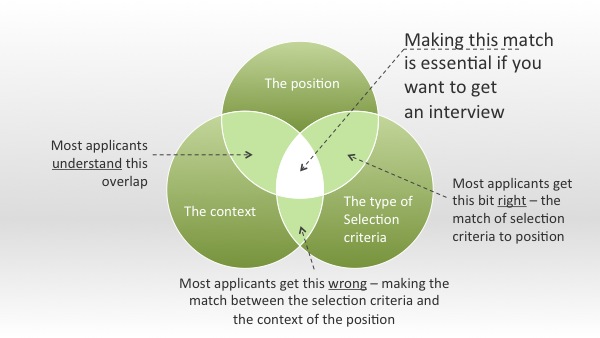
Step 3 - Draft and Refine
The drafting and refining stages includes:
- Writing your first draft.
- Editing your first draft.
- Having someone else read over your work.
Writing Your Selection Criteria Response Draft
Writing selection criteria is a lot like writing an essay (remember those?)
Your document will need to have a beginning (introduction), a middle (the body) and an end (the conclusion). Just like with a high school essay, the body is going to be the most important part because it is where you provide evidence for your argument. (And of course, your argument is that you are the best person for the job!)
Selection criteria as a general rule are inescapably full of three things: 1. Facts 2. Opinions 3. Inferences Most statements addressing selection criteria contain a lot of inferences (make a blanket statement and leave the selection panel to read between the lines or put the dots together), a moderate amount of opinions (sentences or paragraphs without any evidence to back them up, or someone’s general knowledge), and few facts. Good statements addressing selection criteria are the exact opposite. They have lots of facts and barely any opinions or inferences. The best way to pack your statements addressing the selection criteria with facts, is to give solid examples and include measures of success and data if you can.
Addressing Selection Criteria Example
For example, a person applying for a Project Manager position in the APS , with a middle management salary, that is required to work autonomously and with little supervision, would write a prioritising selection criteria like this: "The ability to prioritise your own work"
- Managing four contracts with a value of approximately $12million.
- Supervising and coordinating the work of a team of five project assistants.
- Participating on tender evaluation boards as an independent member.
- Acting as subject matter expert on Selection Advisory Committees for recruitment actions in my own team and other projects.
- Taking on the role of Occupational Health and Safety representative for my building.
- Acting as project manager when the permanent manager is on leave or working internationally.
All these tasks required different time inputs with varying and often conflicting deadlines. In addition, I reported to different people for most of these tasks and have found over the past four years in this role that I have gained exceptional skills in balancing different managers and stakeholders who invariably all want my attention at the same time. I think my excellent organisational and negotiation skills have made it possible to juggle these priorities and keep all parties satisfied that their task has my full attention.
You will notice that the applicant has provided actual examples of what they have done and what they have achieved in the context of the position that they are applying for.
Making this match is essential if you want to make an impression and get an interview.
All three stages are really important. I have seen selection panel members put applications in the 'no pile' simply because someone has had a couple of spelling errors in their selection criteria statements and this has reflected poorly on their written communication skills. A proof read, or having someone else read the application before hand would have meant this person probably would have gotten an interview.
Selection Criteria Examples
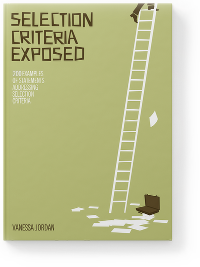
Our free sample of the ebook Selection Criteria Exposed contains free selection criteria examples that you can download right now.

More Help With Your Job Application:

- AED AFN ALL AMD ANG AUD AWG AZN BAM BBD BDT BGN BIF BND BOB BSD BWP BZD CAD CDF CHF CNY CRC CVE CZK DJF DKK DOP DZD EGP ETB EUR FJD FKP GBP GMD GNF GTQ GYD HKD HNL HUF IDR ILS INR ISK JMD JPY KES KGS KHR KMF KRW KYD KZT LAK LBP LKR MAD MDL MKD MMK MNT MOP MUR MVR MWK MYR NGN NIO NPR NZD PEN PGK PHP PKR PLN PYG QAR RON RSD RWF SAR SBD SEK SGD SHP SLL STD THB TJS TOP TTD TWD TZS UAH UGX USD UYU UZS VND VUV WST XAF XCD XOF XPF YER
- 1300 217 374
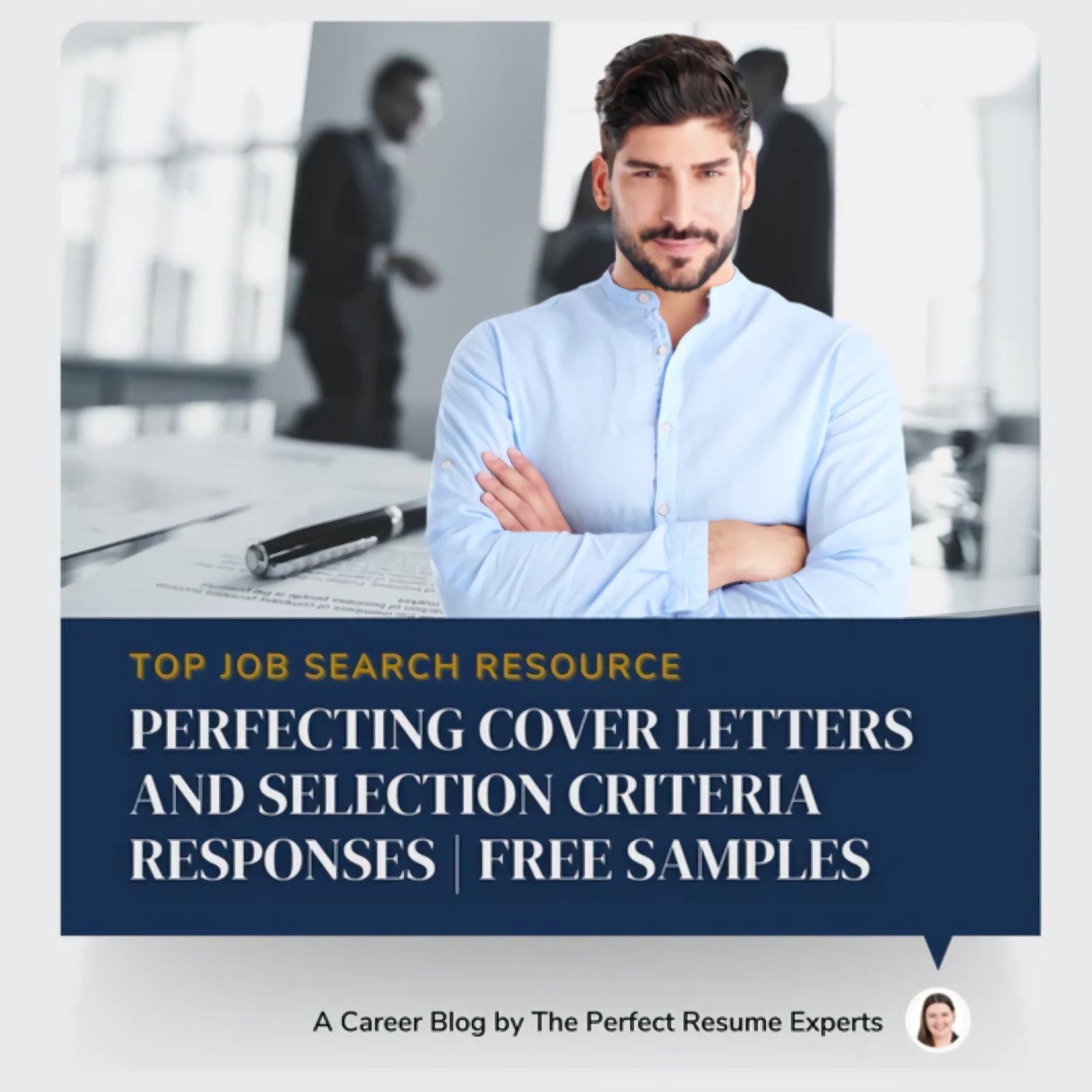
Resume and Selection Criteria Writers Give Away Free Tips
You go back to the job advertisement to upload your resume. But wait!
“Applicants must submit a cover letter and address the selection criteria in the job description,” you shockingly read.
Are you now fuming the internet to find quick hacks on how to write a cover letter and respond to selection criteria ? Have you spent hours finding the best example of a personal statement? Are you feeling overwhelmed with the selection criteria responses you’ve read online and thinking of just letting the opportunity to secure your dream job pass?
Well then, your search stops right here!
The Perfect Resume team is here to guide you and make your job application stand out! We will help you polish your application by providing you with a FREE cover letter and selection criteria samples. Read on and be on your way to landing the job of your dreams!
Cover Letter Dread: The Basics and Effortless Ways to Create One in 2022 — With Examples
A cover letter is a one-page document that aims to express your intention of securing the spot. Like a golden ticket, your cover letter is a paper that introduces you to a potential employer, aside from your resume or CV. Know to some as a motivation letter , your cover letter is submitted to explain and persuade your readers as to why you are the best candidate for the job.
Regrettably, many clients choose to pour all their efforts into perfecting their resumes only. But did you know that your cover letter can be the difference between championing your job search and being sent to the “NO” pile without any hesitation?
“How come,” you ask.
This brief document is a chance for you to showcase your communication skills, experiences, and how you can meet the potential employer’s business needs and exceed expectations. Furthermore, according to SEEK , recruiters and hiring managers still claim to read cover letters to further extract information about applicants, such as their relevant skills and tangible achievement. Zety has shared information that 45% of employers or hiring decision-makers say they expect to receive cover letters. On the other hand, 22% expect letters of interest to be addressed to the Hiring Manager. Thus, it is always a perfect idea to tailor your cover letter to each job application!
Speaking of tailoring or personalising your job search tool, Professional Resume Writers and Career Experts from The Perfect Resume put together a guide on what to include and leave out of your cover letter, including the dos and don’ts when crafting one.
Cover Letter Tip # 1: Never ever forget the must-have sections, namely:
- Contact Section. Up above in your heading section is where your contact information should be ideally placed, such as your mobile number. Why? It is the first thing a recruiter or hiring manager must-see. Without these details, it would be unlikely that you will even hear a callback or stand out from all the other applicants. Therefore, do not ever ditch this part. Additionally, make sure that your contact details are up to date and are reachable.
| 0400 000 000 [email protected] Gold Coast, QLD Click here for LinkedIn |
- Company name, date, appropriate salutation, and the name of the job you're going for. Getting this part right is very crucial. This will reveal if you dedicated enough time to research the company and the person who shall receive your cover letter. As the old saying goes, “well begun is half done.” Addressing the contact person by his or her name will provide a personalised touch and good impression to give you brownie points for an interview shortlist. However, if the information is ungraspable choose a suitable salutation.
| The Perfect Resume Writing Department 2 March 2022
Hiring Manager Position of Professional Resume Writer |
- Attention-grabbing unique selling proposition. This is the best spot to showcase your personality and company values. If you are a person who loves making another laugh, start off with some humour. If you think that the organisation’s cause resonates with you, then it is best to acknowledge it at the beginning of your cover letter. Before you write your introduction, you must identify why do you want to apply for that specific job and why should the employer choose you over the other candidates. Doing this can help you craft a perfect cover letter introduction.
| As an outcome-driven and customer-focused Resume Writer with 10 years of recruiting or sourcing experience, I am eager to deliver high-quality Resume, LinkedIn, and Interview Preparation services to your organisation’s esteemed clients. I look forward to demonstrating an in-depth understanding of the career motivations and achievements of every client, timely completing tasks, and building an improved professional image. |
- Experiences, education, key skills, and achievements. As soon as you have your readers hooked, it is now time to shine by highlighting your standout qualities. Due to the limited time hiring managers hold within the recruitment process, it is best to keep it short but sweet! They do not have time for fluff. Hence why they use applicant tracking systems to sort candidates from being a good fit to not so suitable. So, be sure to address the employer’s wants and needs whilst incorporating your applicable past experiences, skills, and wins – both big and small!
| Currently employed as a resume writer for XYZ company, I perform to a high standard by producing approximately 5 error-free application documents daily. I have also exceeded the satisfaction of various clients and received praises due to timely updating clients on the status of their orders and presenting information in a concise, factual, and strategic fashion. Before this, I worked as a content writer, customer support representative, and teacher, whereby I developed my skills in anticipating clients’ needs. Notable achievements in these roles included delivering outputs prior to the deadline, uplifting new revenue from existing customers, and reducing the number of complaints. Recognised as an enthusiastic, diligent, and high performing professional, I am an avid learner and suitably qualified with a Bachelor of Arts in Mass Communication. |
Cover Letter Tip # 2: Familiarise yourself with mistakes to dodge, such as:
- Never start with “I am writing to apply for the XYZ position at XYZ.” Keep in mind that your cover letter is meant to make you stand out. Aside from being superfluous, beginning your cover letter with this phrase will only give the impression that you are boring or not that interested in the job. Do your research and use your cover letter as a way of communicating how you have what it takes to be the company’s next team member.
- Avoid repeating all the information on your resume . A resume is intended to state facts about your career, such as your previous roles, skills, and achievements. On the other hand, your cover letter is meant to explain how you meet the job requirements. It is an avenue for you to introduce yourself in a creative way and display your communication skills. Therefore, it is unnecessary to copy and paste the information from your resume onto your cover letter. You need to tell an interesting story.
- Eliminate the typos. According to research conducted by CareerBuilder, a trusted human capital solutions company, over 70% of hiring managers admitted that they would reject a cover letter bearing grammatical or typographical errors without a doubt. The same also goes for resumes. Therefore, make sure to proofread your document. It is also advisable to use a free online writing assistant or error-checker. Moreover, try having a trusted colleague review your cover letter. Getting a pair of fresh eyes can help catch language oversights in your relevant experience and enhance the flow of your letter of introduction without paying anything.
- Do not forget the evidence of your knowledge. It is easy to claim that you are a ‘team player’ or have all the right values for the job. However, you are not the first candidate to mention it. Often, cover letters are filled with content that applicants merely copied, such as the role title and expertise listed on the job advertisement without backing them up. Hiring managers go for a good match when they are finding candidates for jobs, someone who can communicate their relevant work experience, how they have demonstrated the required skills in their past and are a great match between the hard and soft transferable skills. In addition to that, you can write your selection criteria or professional resume in a more creative way by sprinkling in the results or achievements. Hiring managers love reading engaging resumes, especially when candidates take the time to write in a results-driven manner.
- Stay away from mentioning your expected salary. Unless you are instructed to do so, it is best to do not to mention to the recruiter or company representative how much you are expecting to receive. Indeed, good compensation in any industry is a form of motivation. However, you want to present yourself to your potential employer as a professional eager to contribute to the future of the company, not someone who is excited to just get paid.
Cover Letter Tip # 3: Create a winning and sincere final statement and call to action.
Your ending paragraph should be as captivating as your introduction. It is also great to include a call of action or a way of encouraging potential employers to contact you for further discussions on how you can be a great asset to the company. Here, you can display your enthusiasm and confidence. Lastly, if you are wondering how to end your cover letter, sign off with kind regards or yours sincerely.
| With an eye for detail and the ability to work collaboratively, I believe in consistency and strive to deliver results. Therefore, I strive to align my skills, experience, and passion for making a difference in people’s lives and careers. I believe I can offer you valuable insight that will result in strategic solutions for your services. I can be contacted on 0400 000 000 or via email at [email protected] at a time of your convenience. I look forward to hearing from you.
Kind regards First Last Name |
Writing a Cover Letter in Australia Doesn’t Have to Be Tough
We know cover letter writing can be hard, but it doesn't have to be! If you're struggling with trying not to sound desperate or keeping your document easy to read, then fear not! Below, there are some cover letter examples for managerial and graduate roles. On the other hand, if you would like your Professional Writer from The Perfect Resume to craft a unique cover letter that suits your needs, email us at [email protected] or visit www.theperfectresume.com.au .
Finance Manager Cover Letter Example
| 2 March 2022
: Hiring Manager - The Perfect Resume Position of Finance Manager,
As an experienced and highly qualified Finance Manager, I look forward to adding value to your bottom line and have attached my résumé for your consideration. I was previously employed as a Financial Accountant for COMPANY, where I managed 5 direct reports and 140 indirect payrolls and accounts staff, based around the world, including overseeing the financial management of 3 company-owned venues and 2 joint ventures. In this role, I successfully implemented project financing, budget forecasting and financial analysis initiatives. I ensured accurate allocation of cost for analysis which decreased expenses by approx. $50k per month. My deep-dive analysis and efforts further led to a reduction of $150k per annum and guaranteed that all accounts receivable, accounts payable, daily reconciliations were performed to a very high standard. Judicious by nature and an adept analytical problem-solver, I have proven experience in project process improvements. Leveraging available resources, I develop and lead a commercially focused and energised team and communicate with excellent verbal, written and interpersonal communication skills to sustain long-term quality productive working relationships. Recognised as an enthusiastic, diligent, and high performing professional, I am looking for a long-term contract within your dynamic finance team. I believe my financial, budgeting, forecasting experience, CPA, and post qualifications, place me in a unique position to offer your company the expertise you are looking for, in addition to an innovative nature and meticulous attention for details to work collaboratively with the team. While I thoroughly enjoyed my previous role, I am now seeking a new position closer to family. Therefore, please find further experience reflected in my enclosed resume to pique your interest to shortlist me for an interview. I can be contacted at [email protected] or 1300 217 374 at a time of your convenience. Kind regards,
|
Graduate Program Cover Letter Template
| Insert Organisation Insert Date Dear Hiring Manager,
Graduate Program opportunity, A team member, I am eager to contribute to for by . employed as a for , I to a high standard by . These activities have provided me with the transferrable skills required to applying for your organisation. Suitably qualified with a , coupled with of experience, I can also confirm that I possess the following qualities as required: While I thoroughly my , I am now seeking a new challenge/long-term career change. Therefore, please find other experiences reflected in my enclosed resume to pique your interest to shortlist me for an interview. I can be contacted at or at a time of your convenience.I look forward to hearing from you. Kind regards
|
Selection Criteria: What is it And How Do I Address It in My Cover Letter?
The key selection criteria demonstrate how well suited you are for your dream job. Your responses are what potential employers shall use to shortlist you for a job. Unlike a cover letter, a selection criteria response is a direct, concise, and focused explanation to a situational question, for example, ‘demonstrate a time when you had to meet tight deadlines' or ‘explain a situation when you had to be flexible,’ You may address this job requirement in your cover letter. How? Through an applicant tracking systems formula:
Example Statement + Example Situation + How you overcame the challenge/problem = Criteria Response Evidence
How do you write the selection criteria for a job application.
There is no one-size-fits-all answer to this question, as the best way to answer selection criteria questions correctly depends on the specific question being asked and the job you are applying for. However, there are a few general tips that can help you to answer selection criteria questions effectively:
- Read the question carefully and make sure you understand what is being asked of you. Selection criteria can vary from employer to employer, so it’s important to read through the job ad thoroughly and understand what is required before you start writing your application. Follow the instructions: make sure you read and understand the selection criteria before starting to write your response.
- Outline how your skills, experience and qualifications match up with what is being asked for in the question. Do not be afraid of referring to previous roles. Employers want someone who can hit the ground running. Therefore, make sure that if you have experience in a similar role and the required qualifications and skills for the position, you want your next employer to know.
- Use specific examples to back up your claims and show that you have what it takes to do the job. A professional resume template will help to strengthen your argument and show that you have what it takes to do the particular job. Numbers and statistics can help add credibility to a document by providing concrete evidence to support a claim. When used effectively, they can help back up an argument with factual information. In addition, they can help to persuade your readers – and make them say, “this is the one!” The best way to use numbers in a selection criteria response is to back up general claims with specific examples. For example, rather than writing, “ I am reliable ,” you could write, “ In the past year, I have worked consistently 5 days per week and have had ZERO unaccounted days off or arrived late on any occasions .” Who would you employ if you could choose between the “I am reliable” guy or someone who has had ZERO unaccounted days off?
- Check for spelling and grammar mistakes before submitting your application. Nothing looks worse than a sloppy job application! Proofreading is so important for job seekers because it is the first impression that you make on a potential employer. If there are spelling and grammar mistakes in your application, it signals to the employer that you are not detail-oriented and that you may not be taking the job application seriously. It also shows that you may not be capable of doing the specific job if you cannot even take the time to proofread your application. By proofreading your job application, you can ensure that your application looks polished and professional.
Is the job you are applying for requesting selection criteria be addressed? Writing selection criteria is a speciality of The Perfect Resume Professional Resume Writers! If you would prefer to address the criteria on your own, the following style is recommended:
| Use the first paragraph of the generic cover and add a line: “In order to display my capability for the role, I have addressed the selection criteria below:” [Insert one to two paragraphs about your experience] [Insert one to two paragraphs about your experience] [Insert one to two paragraphs about your experience] Use the last paragraph of the generic cover letter. Kind regards Your name |
An example of how to plan each criterion:
| |
Then put the paragraph together that you would add into the cover letter:
| While working as a customer service representative, many customers used English as a second language. This made coordinating meeting agendas challenging. To ensure accuracy, I utilised Google Translate, engaged in translator services, used extensive body language and pictures to communicate in a simple English style. These techniques proved successful as I had a high return customer rate and strong relationships were built on enhanced customer satisfaction. |
If you have written your key selection criteria and would like a Professional Resume Writer to proofread it for you we would be happy to. Please click here to get started.
Another Selection Criteria Response Example
| I had been working as a customer service representative for a telecommunications company for 2 years. During the day, I would answer 30-50 customer enquiries per day, depending on the complexity of the customer’s needs. On one particular day, it was rather busy, and I received a call from a customer who was extremely angry. The customer had been trying to call the company for two days and was unable to get through, so she decided she was going to her business elsewhere. Even though I was busy, I knew this customer had called for a reason, other than to tell us that she had chosen another provider, so I decided to take some time to listen to her needs. She told me that her primary line (which she would normally use to call us on) had disconnected after a power outage and she couldn’t turn it back on. She felt isolated and upset not being able to communicate with her family throughout the evening. I assured her that we would investigate this issue immediately and asked if there were any other questions or concerns, she had. After a quick investigation, I discovered that the primary line had not disconnected but there was an outstanding payment on her account which had placed a suspension on the account (which meant the power outage was really not the cause of the problem). I checked the accounts and since this customer had received five years of excellent service from our company, I let her know that I would waive the outstanding charges. She was ever so grateful and let me know that she has now decided to remain with the company. |
How can The Perfect Resume Team Help?
To be successful in your job search, you need to have a compelling cover letter and give it your best shot as you try to address selection criteria. Your cover letter is the first thing that hiring managers will read, and it can help make or break an application. A well-crafted cover letter, coupled with key selection criteria responses should tell the hiring manager why they MUST have you on their team. However, if you still don't know where to start, contact The Perfect Resume today!
The Perfect Resume is here to help you get ahead in your career by providing cover letters and selection criteria responses. We offer professional writing services to make sure your job search tools are perfect before submitting them. Our team of writers is experts in crafting interview-winning documents to impress any hiring manager or recruiter. We know what employers want to see on paper and how they want their candidates presented, so let us do all the hard work.
Please send us an email at [email protected] with your resume, cover letter, and link to your dream job. We will give you tips on making prospective employers hire YOU over ALL OTHER CANDIDATES – without paying a penny!
Likewise, if you find this article helpful, don't forget to share and pass the kindness along to your fellow job seeker!
Recommended reading suggestions
- Why calling the recruiter before you apply for a job helps you land an interview?
- Here’s everything candidates need to know about an ATS
- Job Search Tips: How long do you wait for an interview call?
- Address selection criteria examples
- Create a winning resume format 2024
What Our Client's Say About Our Resume Writing Services
I recommend perfect resume to anyone who is looking for a change in their career or getting into a job. Melissa did a wonderful job on my resume and I got into interviews as soon as I started applying for jobs. No delay. Well done Melissa and team! Great work.
I was miserable at my previous job. Now I have a job I love. TPR helped with a brilliant resume and cover letter.
Melissa is great! She quickly prepared my resume, cover letters & selection criteria. I received multiple interviews, very happy customer! Highly recommend.
Defence Industry related with levels of privacy and discretion. The speed and professionalism of the service they provided me was exceptional. What I loved most was that they were willing to be blunt where others were not. Identifying weaknesses in my resume that most people are blind to see for themselves.
Professional, prompt and easy to deal with. I am very happy with the help that Melissa and her team provided to me. I had a fresh, new, exciting and professional resume plus an accompanying cover letter in just a few days, together with great advice, tips and encouragement. I couldn't recommend The Perfect Resume more highly.
Melissa was awesome. She engaged me in the process, gave really good insight and did a fantastic job with my resume. I had previously got someone else to redo my resume for me and they had done a really bad job. But this one is amazing and up to date and all ATS tracked and checked. I would HIGHLY recommend this company if you need help with resumes, cover letters and LinkedIn! They know what they are doing and really work with you.
I recently had the pleasure of working with The Perfect Resume to enhance my resume, and I am extremely pleased with the results. The team at The Perfect Resume demonstrated a high level of professionalism, attention to detail, and a genuine commitment to helping me present my qualifications in the best possible light. From the initial consultation to the final draft, the process was seamless and efficient. The expert resume writers at The Perfect Resume took the time to understand my career goals and tailored my resume to highlight my strengths and achievements. They not only polished the content but also provided valuable insights on industry trends and resume best practices. I appreciated the open communication throughout the collaboration, as the team was responsive to my feedback and ensured that the final document truly represented my professional journey. The refined resume not only showcases my skills and experiences but also reflects a contemporary and visually appealing format. Thanks to The Perfect Resume, I now feel more confident about my job search, armed with a well-crafted resume that sets me apart from the competition. I highly recommend The Perfect Resume to anyone seeking professional resume services – their expertise and dedication to client satisfaction truly make them stand out in the field.
How Our Resume Writing Services Work
Fill in the form to request a professional resume writer or career coach to review your resume or cv for free.
Cover letter template
Explain to the employer the purpose of your letter, why you’re applying for the job, how you meet the job criteria, and how they can contact you for an interview.
Cover letters for job applications
[your street number and name] [your suburb, state and postcode]
[title and name of addressee] [his/her position title if known]
[organisation’s name] [organisation’s address]
Dear [insert Ms/Mr Xxx or Sir/Madam]
Application for position of [name of role], Reference Number [if given]
OPENING PARAGRAPH(S): The purpose of this letter, and why them.
Paragraph 1 : start by referring to the position you’re applying for (or “I am applying for the above position” if formatted as above) and where you saw the advertisement or heard about the role.
Paragraph 2 : explain why you’re interested in the role and the organisation. In order to do this, you need to have thoroughly read the selection criteria relating to the role and researched the organisation using their website, news sites, industry contacts, and so forth. If you’re applying through a recruitment agency and don't know the name of the hiring organisation, you can research the industry instead. Try to avoid clichés and make your interest in the organisation appear personal and genuine. A brief summary of your key selling points can be included at this point to highlight your ‘organisational fit’.
eg, GreenBuild’s recent exhibit at the Sustainable Cities festival was of particular interest to me as I have a passion for sustainable development. My skills in residential design developed through my Bachelor of Design in Architecture, along with my thorough knowledge of sustainable building practices acquired over two years as a project officer with the NSW Department of Environment and Heritage, would allow me to make a meaningful contribution to your mission to create Sydney’s greenest housing developments.
MIDDLE PARAGRAPHS: Why you?
Paragraph 3 : this is where you provide evidence as to how your qualifications, skills and experience meet the selection criteria for the position. You can draw evidence from a range of experiences if relevant, including academic studies, extracurricular activities, placements, volunteer roles and paid employment history, including casual work. This section where you address the selection criteria should be the longest section in your letter. It may be necessary to divide it into more than one paragraph.
eg, My strong time management skills have been developed through balancing part time work at Bob’s Café with volunteering commitments at my local community centre while meeting all assignment deadlines to maintain a distinction average in my studies.
FINAL PARAGRAPH: Wrap-up
Paragraph 4 : this is where you express the hoped-for outcome of your letter. End on a positive note and a call to further action. You may want to reiterate how your relevant strengths make you a suitable candidate for the role and mention your availability for interview. Refer to any attachments such as resume, transcript, application form, etc.
Yours sincerely [your name typed]
[Note: Use ‘Yours sincerely’ for letters beginning with ‘Dear plus Addressee’s Name’ and ‘Yours faithfully’ for letters beginning with ‘Dear Sir/Madam’]
Speculative cover letters
Speculative cover letters are used when you are proactively seeking opportunities directly with an employer, rather than responding to advertised vacancies. For speculative letters, follow the format above, with the following adjustments:
Opening paragraph : If you’ve been referred by a friend or colleague known to the recruiter, mention this. As no job has been advertised, state that you’re seeking employment opportunities in a particular occupational area or role.
Final paragraph : You may wish to include your intention to contact the employer on a particular day to follow up. Make sure that you keep your promise by noting the date in your diary and contacting the addressee on the mentioned date, as planned.
Need more cover letter tips?
How to write a cover letter.
A cover letter is your first introduction to a potential employer, so it needs to show that you’re a suitable candidate.
Addressing selection criteria
Selection criteria are the skills, knowledge, and experience required to successfully do the job.
How to write a resume
A clear, tailored and professional resume is essential for any job application. It should aim to convince an employer that your qualifications, work experience and skillset make you a strong match for the job.
Jobscan > Cover Letter Writing Guide
How To Write A Cover Letter in 2024 (Expert Tips and Examples)
Here’s a comprehensive guide on how to write a cover letter that will get you noticed by recruiters.
Trusted by:
A survey revealed that 77% of recruiters prefer candidates who send in a cover letter, even if submitting it is optional. Additionally, 90% of executives consider cover letters invaluable when assessing job candidates.
So, if you think cover letters are no longer important and necessary in 2024, think again.
Here’s a comprehensive guide to help you write a cover letter that effectively sells your skills and professional experience, increases your chances of getting interviews, and gets your foot in the door.
Table of Contents
What is a cover letter and do you still need one in 2024?
A cover letter is a letter of introduction accompanying your resume that paints why you are the best person for the job, what you bring to the table, and how you can help move the company forward.
Is the cover letter dead? No! In fact, a recent study by ResumeLab revealed that 64% of job vacancies still require that you include a cover letter in your application and 83% of HR pros said that cover letters are important for their hiring decision.
The bottom line is that a cover letter is still a valuable piece of your job search collateral. Nail your cover letter and you could end up getting that dream job.
So what exactly do you need to accomplish in your cover letter?
What is the purpose of a cover letter?
According to 49% of HR managers , your cover letter is the second best way to call attention to your resume and distinguish yourself from other applicants.
So the main purpose of your cover letter is to compel the recruiter to read more about you on your resume and move you to the next part of the hiring process.
Further, according to award-winning resume expert Melanie Denny , your cover letter is your value proposition letter. It proves why you are the best candidate to address the company’s needs with the professional skills and qualifications to succeed in the job.
Here’s an example of a great cover letter:

Now let’s get into the details of what your cover letter needs to include.
Cover Letter Structure Checklist
Here’s a quick rundown of what you need to include in your cover letter.
- Contact Details Name Address (or City, State with zip code) Phone number Email address
- Greeting Whenever possible, address the hiring manager by name.
- Opening Who are you? What are your relevant skills and accomplishments?
- Body (1-2 paragraphs) What do you know about the company? Why are you applying for this job? What value can you bring to the company? Include measurable results when possible.
- Closing Reiterate your interest. Add a Call to Action. Mention any attachments. Use a professional sign-off like “Best” or “Sincerely” before your full name.
Here’s an example for the visual learners out there:

Now that you know the basics of what to include in your cover letter, let’s go through the process from start to finish to see how you can write a cover letter that will make you stand out from the rest of the candidates.
How to write a cover letter in 9 steps
It can be intimidating to try to parse down all your best qualities into a few quick paragraphs for your cover letter.
Here are 9 steps you can take to make sure you’re headed in the right direction:
Step 1. Do your research
Before writing your cover letter, thoroughly read the job description and the requirements for the job.
Melanie Denny , award-winning resume expert, likens the job description to your cover letter cheat sheet. And when checking the job description, she says you need to consider the following:
- What are the company’s priorities?
- What are their goals for the role?
- What outcomes and accomplishments in your previous roles match the goals?
- What are the key phrases and verbiage the company uses?
This will help you customize your cover letter, angle yourself and your narrative to fit the role better, and impress the hiring manager.
Try reaching out to the recruiter, hiring manager, or someone working in the company if you want more in-depth information about the company and the position you are applying for.
Step 2. Customize your cover letter for every job
Make sure your cover letter matches the job you are applying for. Writing a generic cover letter is a missed opportunity as this will not appeal to the recruiter or hiring manager. According to research from ResumeGo , 81% of HR professionals value job-specific cover letters over generic ones. Jobseekers who had tailored cover letters received a 53% higher callback rate compared to those who had no cover letter.
Remember, your cover letter is your chance to prove that you are passionate about working for a given company, so take the time to write a tailored cover letter for each position . You can do this by mentioning your skills and experience that are directly related to what’s mentioned in the job description. If you’re applying for a data analyst role that requires expertise in Microsoft Power BI, cite an example of a Power BI dashboard you built and how it helped the company.
Read our full guide: How to Optimize Your Cover Letter
Step 3. Include all of your contact info
You should make it easy for the hiring manager to reach you. In your cover letter, list these three things:
- Address (including zip code– for ATS purposes )
- Phone number with area code
- Email address
- Name of the Hiring Manager
- Name of the Company
- Address of the Company
Traditionally, your contact information is included in the upper left corner of your cover letter if you’re writing in a document. If you’re writing an email, this can be included beneath your signature at the end of the message.
Cover Letter Header Example:
Jane Jobscan Seattle, WA 98101 (555) 555-5555 • [email protected] linkedin.com/in/jane-jobscan
February 25, 2024
Lavinia Smith Hiring Manager Media Raven, Inc. Plantersville, MS 38862
Step 4. Address your cover letter to a real person
According to Melanie Denny, resume expert and President of Resume-Evolution, addressing your cover letter to a real person and addressing them by their name feels more personal and shows recruiters and hiring managers that you took time and did the research.
You can usually find the hiring manager’s name by searching the company website or LinkedIn profile, or by calling the company and asking which hiring manager is assigned to the particular position.
Once you learn the name, a simple greeting of “John” or “Hello John” is all you need.
If you can’t find the hiring manager’s name, you can use any of the following:
- Dear Hiring Manager
- Dear (Department) Team
- To whom it may concern
Read our full guide: How to Address a Cover Letter
Step 5. Write a strong opening statement
Melanie Denny suggests that you start your cover letter with a bang. This will hook the hiring manager’s interest and show them how you can be a valuable addition to the team.
Here are things you can do:
- Open with a thought-provoking question
- Make a big claim about what you can do for the company
- Say something relevant and specific to the company
For example,
“I want to bring the marketing department of Media Raven Inc. to the next level and help the company exceed goals and reach more customers as Marketing Manager.”
Step 6. Prove how your professional background and skills help the company in the body of your cover letter
Take advantage of this real estate and prove to the prospective employer how your background, values, and professional experiences position you as the best fit for what the role requires.
This is especially important if you are switching careers. Highlight your relevant accomplishments in your cover letter, showcase your transferable skills, and explain how you can help the company address its challenges and succeed.
For example:
“As the Director of Marketing at ABC Company since 2018, I directed all phases of both the creative and technical elements of marketing initiatives, including data mining, brand creation, print/web collateral development, lead generation, channel partner cultivation, customer segmentation/profiling, as well as CRM and acquisition strategies.
Perhaps most importantly, I offer a history of proven results, as evidenced by the following marketing accomplishments for my current employer:
- Captured a 28% expansion in customer base since 2018, achieved during a period of overall decline in the retail industry.
- Led national marketing campaign (comprised of trade shows, media, and PR initiatives) for my company’s newly launched technology services division
- Developed and executed SEO strategy that achieved and sustained top 3 rankings on Google (organic, nonpaid results) for key product search terms.
- Oversaw the creation of a new company logo and rebranded 100+ products to cement a cohesive corporate identity and support new company direction.”
Just like when writing a resume, your cover letter should only include the most relevant and positive information about you. To home in on the right skills and qualifications to mention, try scanning your cover letter .
Read our full guide: What Do You Put in a Cover Letter?
Step 7. Write a strong closing statement and a call to action
Use the closing of your cover letter to:
- Thank the hiring manager for their time
- Mention any attachments (resume, portfolio, samples)
- Invite to schedule an interview
- Let the hiring manager know that you will follow up
Keep the closing professional and try not to sound too eager since that can come off as desperate. You must also keep in mind the tone and personality of the company you’re communicating with.
“Given the opportunity, I’m confident I can achieve similar groundbreaking marketing results for Media Raven, Inc.
Ms. Smith, I would welcome the chance to discuss your marketing objectives and how I can help you attain them. Feel free to call me at (555) 555-5555 or email me at [email protected] to arrange a meeting. I look forward to speaking with you.”
Read our full guide: How to End a Cover Letter With a Call to Action
Step 8. End with a professional closing salutation
To finish out the closing , use a formal signature. You can use “Sincerely,” “Best,” “Regards,” “Yours,” or any other professional signoff.
Use your first and last name as your signature. If you’re sending your cover letter in the body of an email, make sure it’s your personal email account that does not list your current work signature beneath the email. Your other option is to write the cover letter in a word document, save it as a PDF, and attach it to your email.
Step 9. Optimize your cover letter for the ATS
The Applicant Tracking System or the ATS is a software that companies use to screen applications and shrink their pool of applicants. Through the ATS database, a recruiter or hiring manager can just search for specific skills and keywords and the ATS will return a list of the top candidates who match the search criteria.
To optimize your cover letter for ATS, you need to:
- Carefully read the job description
- Take note of skills and resume keywords frequently mentioned
- Incorporate these keywords into your cover letter
Read our full guide: How to Optimize Your Cover Letter to Beat the ATS
Does your cover letter pass the test?
Scan your cover letter to see how well it matches the job you're applying for. Optimize your cover letter and resume with Jobscan to get more interviews.

How to Format Your Cover Letter
A cover letter is a letter, but that doesn’t mean you should just plop everything onto the page in a stream-of-consciousness flow. After all, cover letter formats determine the order in which the hiring manager learns about you, which can significantly influence their first impression. Use the format order below as a guideline for building the structure of your cover letter.

Notice how the topics flow like a conversation? When you first meet someone, you introduce yourself, tell them your name and a little about yourself, and then leave the conversation open for future meetings.
Your cover letter is just a like having a conversation with someone for the first time. Keeping that in mind will help you to keep things simple and focus on the right information.
Below are some examples of how to format your cover letter for different types of applications.
How to format your cover letter for a job
- State your name
- Explain your work history
- Tell them what you can do for their company
- Say goodbye
How to format your cover letter for an internship
- Explain your coursework history and education
- Explain what you can gain professionally
How to format your cover letter with no experience
- Explain your skillset and character qualities that make you well-suited for the role
- Outline entry-level achievements
You can also check out our cover letter templates to help you as you write your own cover letter.
Do you want to save time and receive instant feedback on your cover letter? Check out Jobscan’s cover letter tool .
Read more : How to Write a Resume for Today’s Job Market
Cover Letter Examples
Here are some examples to help you create a cover letter that will make you stand out and give a strong first impression.
1. Internship Cover Letter Example

2. Career Change Cover Letter Example

3. Operations Manager Cover Letter Example

4. Communications Professional Cover Letter Example

5. Software Engineer Cover Letter Example

Cover Letter Do’s and Don’ts
Aside from the basic steps of how to write a cover letter, there are some things you definitely need to make sure you avoid – and things you can’t skip! Follow these do’s and don’ts for writing a cover letter, and you’ll end up with a much better result.
- Use a cover letter unless one was requested.
- Attach a cover letter directly to your resume unless requested to do so.
- Use the same boilerplate cover letter for multiple job applications.
- Over-explain your work history, employment gaps, or qualifications – save it for the interview.
- Badmouth any of your past employers.
- Use the cover letter to complain or tell about your job search journey.
- Use non-standard formatting like tables, columns, or graphics. (ATS can’t read those and your cover letter copy might not be scannable by the system.)
- Use long paragraphs.
- Customize a cover letter for every job application that asks for one.
- Incorporate the top skills or keywords from the job description in your cover letter.
- Include the company name and address, the job title, and point of contact’s name on your cover letter.
- Incorporate relevant and compelling measurable results in your cover letter.
- Explain, briefly, any dramatic shifts in a career (i.e. you are changing industries or job titles).
- Use company information to relate your interest in the job.
- Keep your cover letter concise.
- Convey WHY you are right for the position.
More Cover Letter Tips
- When emailing your cover letter, be strategic with your subject line. Never leave the subject line blank, and double-check for specific instructions in the job posting. If possible, use the email subject line to sell yourself. For example: “Experienced Software Engineer Seeks Senior Level Mobile Position.”
- Keep your cover letter brief and to the point. The hiring manager will be reading many cover letters. By carefully selecting your words and experiences to include, you can stand out from the crowd of applicants.
- Be confident. Let the hiring manager know the reasons why you deserve this position, and make yourself believe them too!
- Your cover letter should not be simply a rephrasing of your resume. Let your personality show and go into further detail about your most valuable skills and experiences.
- Do your research on the company and position before writing the cover letter. It should be customized to that specific company’s values and needs. Hiring managers can spot a generic resume from a mile away.
- Use the job posting as your guide for what topics, skills, and experience to focus on.
- The best cover letters include keywords from the job posting. Applicant tracking systems may scan your cover letter along with your resume and will be using these keywords to sort through the applicants.
- Check for spelling and grammar errors.
- Send your cover letter as a PDF to avoid readability issues and to present the most professional application package.
- Scan Your Cover Letter with Jobscan to make sure you’re checking all the boxes.
Optimize Your Cover Letter with Jobscan’s Cover Letter Scanner
In addition to resume scans, Jobscan Premium users can also scan their cover letters against a job description.
This generates a report of the top hard skills and soft skills found in the job description that should be included in your cover letter, plus additional checks for optimal length, contact information, measurable results, and more.
Here’s how it works:
Key Takeaways
Your cover letter gives recruiters, hiring managers, and prospective employers an overview of your professional qualifications and relevant accomplishments that position you as the best candidate for the job.
So you have to make your cover letter powerful and interesting enough to make the recruiter or hiring manager read your resume and move you to the next step of the hiring process.
Here are key pointers when writing your cover letter.
- Make sure you’ve read the job description and done your research about the company.
- Get to know the name of the recruiter or hiring manager so you can address your cover letter properly.
- Include relevant and measurable accomplishments in the body of your cover letter to prove to the hiring manager that you have what it takes to succeed in the job.
- Keep your cover letter short and concise.
- Your cover letter is not a substitute for your resume so don’t just copy and paste whatever is in your resume into your cover letter.
One last important reminder!
Having a strong cover letter is not enough. You also need to create a killer resume to make sure you stand out and land job interviews.
Learn more about writing a cover letter
How to Address a Cover Letter
10 Tips for Writing a Cover Letter
The Career Change Cover Letter: How to Get it Right
What Do You Put in a Cover Letter?
Is Your Cover Letter Robot-Approved?
How to End a Cover Letter with a Call to Action
Frequently asked questions, what are the different types of cover letters.
There are four types of cover letters.
- Application cover letter An application cover letter is what you send to the recruiter or hiring manager along with your resume.
- Prospecting cover letter You send this when you want to inquire prospective employers about open positions in their company or put yourself top-of-mind when they do decide to hire.
- Networking cover letter You will send this to professionals in your network in hopes of getting referrals, introductions, job search advice, and job opportunities.
- Career change cover letter This is what you send when you are switching careers or industries.
What tense should I use when writing a cover letter?
It can be appropriate to change tenses throughout your cover letter.
For example, you can explain who you are in the present tense and explain important aspects of your work history in the past tense. You can switch to future perfect tense when discussing the ways you would perform if given the position.
Think of it like this, “I am ABC, I did XYZ previously, and I look forward to doing EFG in this position.”
What to include in a cover letter
Our cover letter guidelines above explain how to write a cover letter more deeply, but in summary, you should always include your name, relevant work experience, and reasons why you are right for the job in your cover letter.
When not to include a cover letter
- When the job posting clearly states not to include a cover letter
- When you don’t have the time and energy to customize your cover letter. It’s better not to send a cover letter than to send a half-baked and mediocre one.
- When you are applying online and there is no field to upload your cover letter.
- When your cover letter has a lot of typos and errors.
What should you send first: a cover letter or a resume?
Typically, your cover letter and resume will be sent as a pair, but your cover letter is meant to be an introduction to your resume. If it is an email, use the cover letter in the body and attach your resume, otherwise, attach both.
Pro Tip: Be sure to review all instructions in the job description to follow the hiring manager’s requests.
How long should a cover letter be?
According to 70% of recruiters, a cover letter should not exceed 250 to 300 words.
Although there is no hard and fast rule about this, the ideal cover letter length should be around half a page to one full page in length to keep your message concise, clear, and easy to digest.
Should a cover letter be sent as a file attachment?
If it is not specified in the job posting, a cover letter can be sent either as an attachment (PDF is best) or in the body of an application email with your resume attached.
How to share a cover letter with a potential employer
There are several methods of sharing a cover letter with potential employers, depending on their application process.
Cover letters can be written on a document and turned into a PDF to be uploaded to a job application website or attached to an email along with your resume.
In other cases, your cover letter can simply be written in the email message to a hiring manager, with your resume attached.
How to title and save your cover letter
The key in every aspect of job applications is to make yourself an easy “yes” for your potential employer. That means making it easy for the hiring manager to keep track of your application materials for later review. With this in mind, make sure your full name and the phrase “cover letter” are included in the file label. Other helpful details might include the job title you’re applying for or the year of your application.
Here are a few examples:
- Your Name_Cover Letter_Job Title.pdf
- Cover Letter_Your Name_Job Title.pdf
- Job Title_Your Name_Cover Letter.pdf
- Your Name_Cover Letter_2024.pdf
- Cover Letter_Your Name_2024.pdf
Explore more cover letter resources
Cover Letter Formats
ATS-Optimized Cover Letter

Cover Letter Templates
Generate a personalized cover letter in as little as 5 seconds
Say goodbye to the stress of writing a cover letter from scratch. Our AI-powered cover letter generator uses GPT-4 technology to create a personalized and ATS-friendly cover letter in one click. Stand out from the competition and land more job interviews.


Selection Criteria VS Cover Letters
Selection criteria vs. cover letters – there is a difference.
For potential candidates that are sourcing a role in one of the government sectors, Selection Criteria is something you may need to answer. Depending on how well you address each of these could depend on whether you gain an interview spot so it is critical that you get this right.
Most people often don’t realise there is a HUGE difference between a response to Selection Criteria and a Cover Letter.
What is a Selection Criteria response?
- Is no more than 2 pages, addressing Key Responsibilities (or Key Selection Criteria) (4-8 questions)
- Is answering these questions using the STAR method (which is Situation, Task, Action, Result)
- You are required to respond to each question about a “time when” you were in a Situation, doing a specific Task where your Action was required, and then the Result. Use one example per question in a paragraph
- Without this (if the advertisement asks for it), you will not proceed to the next round for interview
What is a Cover Letter?
A Cover Letter is an introduction to yourself, to accompany your resume when you apply for a job.
- Is 1 page only
- Talks about you and why would you be suitable for the role
- Doesn’t cover all your skills (as the resume does this) but more so, it covers your personality traits
- You can talk about 1 main skill they require for the role and HOW you can use this in the new role
- Uses passion and juicy words to attract the reader’s attention
Most people find it more difficult to write a selection criteria response than it is to write a cover letter. The good news though: thinking through examples of your work history to use as answers is also great preparation for your interview.
If you have your heart set on a job that has Selection Criteria, but you don’t know where to start, we recommend you seek professional help.
BOOK YOUR FREE 15 MINUTE CAREER CONSULTATION NOW!

Don’t wait for the right opportunity. Create it.
Book in for a free 20-minute career strategy session with one of our consultants, so you can start taking action today!
Kate Langford Career Consulting – An Award-Winning Career Consulting Firm. We believe in helping people find work they love.
HELPFUL LINKS
Blog categories, all rights reserved 2022.

Professional services for companies and job seekers
- Apr 15, 2021
How To Address Selection Criteria in a Cover Letter Format
A cover letter is an essential part of any job application. It’s your chance to prove to the employer why you feel that you would be an excellent fit for the role.
The team at Client Centric , one of Australia’s best cover letter writing service in Australia, believe that it’s essential every application includes both a CV and cover letter . Most employers these days expect both documents, and rightly so.
RELATED ARTICLE: Five Of The Most Commonly-Used Selection Criteria In Australia
The employer needs to know why someone wants to work for their organisation and precisely what they have to offer concerning the role requirements. Your professionally written CV outlines your skills and experience. The cover letter takes it a step further.
Have you ever wondered how you can write responses to key selection criteria in the format of a cover letter?
My suggestions are first to write the cover letter as you usually would. Then, include each of the key selection criteria and weave it into the cover letter. Keep it brief, straight to the point and not too lengthy. It’s meant to be a cover letter. And generally speaking, a cover letter is about a page long in length .
RELATED ARTICLE: How Selection Criteria Responses are Weighed. What YOU Need To Know
If let’s say there are ten key selection criteria in the position description. Unless the employer has specifically asked you to address each criterion in your cover letter instead of just including it, I will interpret it as they want you to consider the selection criteria as part of your cover letter.
You don’t have to be the best selection criteria writer to write great responses. All you need to do is to make sure that you can address each criterion and meet their requirements.
#addressingkeyselectioncriteriajobmelbourne #Helpaddressingselectioncriteria #AdelaideSelectionCriteriaWriter #AddressingKeySelectionCriteriaPerth #Australianjobs #GovernmentSelectionCrtieria #AdelaideBestResumeWriter #ClientCentricExecutiveEmploymentSolutions #AddressingSelectionCriterias #addressingselectioncriteria #SelectionCriteriaWritingServicesSydney #addressingkeyselectioncriteriaMelbourne #ClientCentric #Bestpracticecoverletter #Addressingrequirementsofjob #SydneyBestCVwriter #TeachingSelectionCriteria #AddressingKeySelectionCriteria #SelectionCriteriaSydney #coverlettertemplate #SelectionCriteriaNursing #CoverLetterWriting
- Application Letter Writing
- Client Centric Executive Employment
- CV and Cover Letter Writing

IMAGES
VIDEO
COMMENTS
Here are a few steps on how to address key selection criteria in a cover letter: 1. Review the job description. Companies often include required selection criteria in the job description. All public sector roles include these criteria. As you review the job description, find the keywords to include in the body of your cover letter. This can ...
4. (Body Paragraphs): Paraphrase Each Criterion and Your Experience. Write an introductory sentence for each criterion, paraphrasing the language and keywords used in the selection criterion. 5. (Body Paragraphs): Brainstorm Ideas for Each Criterion. Make some notes within your document, then choose your 'best ideas'.
Make your points relevant to the job you're applying for. Keep your cover letter short and concise with about three paragraphs and bold a couple of the essential words to make them pop off the page. 5. Close the letter by restating your interest. In the final paragraph, say how much you'd like the position again.
Overall cover letter structure. Integrate your answers into the overall structure of your cover letter. Start with an introduction that briefly talks about the role you're applying for and why you're interested. Then address the key selection criteria, using a paragraph for each criterion. Finally, finish with a summary of your enthusiasm for ...
How to write a 2-page cover letter that addresses government requirements. More and more, there are content length limitations placed on selection criteria responses, and the majority of the time, these are two pages, or roughly 1500 words. This has been implemented by the Commonwealth and most state governments in response to enormous ...
How to address selection criteria. To address selection criteria in a one-page cover letter, see our cover letter tips and template.. Your responses to the selection criteria in a statement of claims or online application form will be more detailed and contain enough evidence to convince the employer that you meet the job criteria. A simple one- or two-line answer will rarely be sufficient.
By addressing these criteria in your cover letter, you can improve your chances of advancing to the next stage of the recruitment process. In this article, we explore more about what 'key selection criteria' is, look at common criteria on job ads, and provide a selection of criteria response examples you can use as a guide for your cover ...
Your statement addressing the selection criteria is the place to give more detailed information about yourself and your ability to do the job. The examples of covering letters include: A pro-forma letter highlighting the types of information that could be included in a letter; how a covering letter for a particular University vacancy might look.
How to address the selection criteria. The required experience, skills, personal attributes, qualifications, knowledge and expertise needed to do a job effectively are outlined in the selection criteria of a job spec. It is vital you match your qualities to this outline when developing your CV and writing your cover letter.
Examples of selection criteria; Meeting the requirements; Addressing the criteria; Additional information; Example; Selection criteria and why are they used. Selection criteria represent the key qualifications, training, abilities, knowledge, personal attributes, skills and experience a person must have in order to do a job effectively.
Generally speaking, most cover letters are just a page long. However, because you need to address selection criteria within your cover letter, likely it will go over to two or more pages. So, with any cover letter, make sure that your letter has all the primary details (address, employer name, your name, date, etc.) plus an introduction and a ...
Addressing key selection criteria in your cover letter. Follow up with more detailed examples of how you demonstrated these skills in the cover letter, using paragraphs. For example: In addition to study, I have also been working part-time in customer service roles in both hospitality and retail settings. ... Addressing key selection criteria ...
Some positions require that you address the key selection criteria on a separate page from your resume or cover letter. If that's the case, make it an addition to your application. In paragraph format, address each criterion specifically, making sure that you use their phrasing and keywords so as to best highlight the way that you meet their ...
Samples and examples of selection criteria in a variety of formats, depending on your application requirements: Traditional selection criteria examples, three quarters to one page long, each. Short selection criteria with a 250 word limit. How to address selection criteria when they are requested to be written in a cover letter.
2. Cover letters that address the selection criteria: These can be anywhere from 2 to 4 pages in length depending upon the job listing requirements and require you to address all the selection criteria within the cover letter. By understanding the different types of cover letters, you are able to pick the most suitable letter that will help you to
Unlike a cover letter, a selection criteria response is a direct, concise, and focused explanation to a situational question, for example, 'demonstrate a time when you had to meet tight deadlines' or 'explain a situation when you had to be flexible,' You may address this job requirement in your cover letter.
The headline on the image says, "Cover letter format" A woman sits at a table writing on a piece of paper. There's a simple cover letter represented by lines. On one side of the cover letter, there are labels for the sections of the cover letter. The labels are: 1. Date and contact information 2. Salutation/greeting 3. First, introduce yourself 4.
The third step to writing a cover letter for a government job is to use the STAR method to address the selection criteria and key requirements. The STAR method stands for Situation, Task, Action ...
Cover letters for job applications. [date] Dear [insert Ms/Mr Xxx or Sir/Madam] Application for position of [name of role], Reference Number [if given] OPENING PARAGRAPH (S): The purpose of this letter, and why them. Paragraph 1: start by referring to the position you're applying for (or "I am applying for the above position" if formatted ...
Applicants are also benefited by the selection criteria, as it gives you a better understanding of what the job requires and you will be able to assess your own capabilities against the requirements of the job. • How to Address Selection Criteria 1. Create a new document 2. Address each criteria individually 3.
Adding titles when addressing a cover letter. It is acceptable to use a title and the recipient's surname when addressing a cover letter. You could write "Dear Mr Nelson" instead of "Dear Chris Nelson.". You might do this if you do not know your recipient's first name. Call females Ms, unless you know they prefer Miss or Mrs.
Step 4. Address your cover letter to a real person . According to Melanie Denny, resume expert and President of Resume-Evolution, addressing your cover letter to a real person and addressing them by their name feels more personal and shows recruiters and hiring managers that you took time and did the research.
A Cover Letter is an introduction to yourself, to accompany your resume when you apply for a job. Most people find it more difficult to write a selection criteria response than it is to write a cover letter. The good news though: thinking through examples of your work history to use as answers is also great preparation for your interview.
Addressing a cover letter sent by email. Addressing a cover letter to send via email slightly differs from a printed one. A printed letter would include the recipient's address and the date, which is unnecessary in an email, as the letter will be the body of the email. However, your email still needs to be as professional as a traditional cover ...
A cover letter is an essential part of any job application. It's your chance to prove to the employer why you feel that you would be an excellent fit for the role. The team at Client Centric, one of Australia's best cover letter writing service in Australia, believe that it's essential every application includes both a CV and cover letter. Most employers these days expect both documents ...
The best cover letter templates offer a structured framework for developing a well-organized document. Our cover letter templates can save you time and give you a significant jump start. Rather than beginning from scratch, you can focus your efforts on customizing the content to fit your specific situation and the requirements of the particular ...
5. Career change cover letter example. Writing a cover letter for a job in your current industry is pretty straightforward. But writing a career change cover letter requires a slightly different approach. The sample cover letter below includes the three elements you need to persuade a hiring manager you're ready to transfer industries: